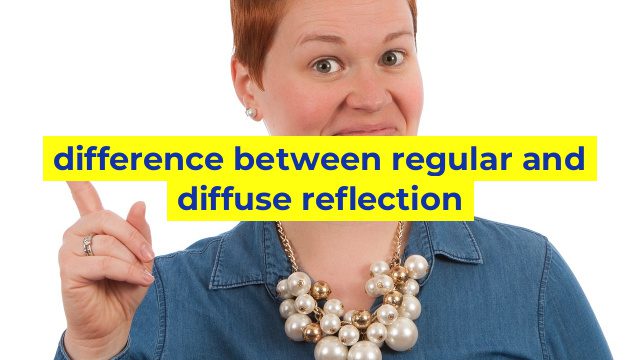The Difference Between Regular and Diffuse Reflection
Reflection is an essential phenomenon in optics, wherein light waves bounce off a surface and change direction. Two types of reflection exist, namely regular and diffuse reflection. These two types differ in several aspects, including their appearance and how they occur.
Regular Reflection
Regular reflection occurs when light waves bounce off a surface at an equal and opposite angle to the incident angle. This type of reflection is also known as specular reflection because it produces a mirror-like image of the object on the surface. Regular reflection occurs with smooth and polished surfaces, such as glass, mirrors, and still water.
When light strikes a smooth surface, it bounces off in an organized manner, reflecting the same angle as the incident angle. The reflected image appears clear and distinct, and its orientation is identical to the original image’s orientation. Regular reflection also obeys the law of reflection, which states that the angle of incidence equals the angle of reflection.
Diffuse Reflection
Diffuse reflection, on the other hand, occurs when light waves strike a rough surface, creating a scattered reflection rather than a clear one. The incident light rays bounce off different angles on the surface, appearing to radiate from various points. As a result, the reflected image appears dull and hazy, and it looks very different from the original image.
Diffuse reflection occurs naturally with surfaces such as paper, fabric, and walls. These objects have a rough texture that causes light waves to scatter in different directions. The reflected light is not parallel, so the observer cannot see an image in the reflection.
In conclusion, regular and diffuse reflection are two distinct phenomena that differ in their appearance and occurrence. Regular reflection occurs with smooth and polished surfaces, creating a clear and distinct image that obeys the law of reflection. Diffuse reflection, on the other hand, happens with rough surfaces, producing a scattered reflection that is dull and hazy, and bears no resemblance to the original image. By understanding the difference between these two reflection types, one can appreciate the science behind optics and the fascinating behavior of light waves.
Table difference between regular and diffuse reflection
| Regular Reflection | Diffuse Reflection |
|---|---|
| Occurs when light waves reflect off a smooth surface at the same angle they hit it | Occurs when light waves reflect off a rough surface at various angles in different directions |
| The reflected light is usually more intense and clear | The reflected light is usually less intense and scattered in different directions |
| Commonly seen in mirrors and other highly-polished surfaces | Commonly seen in non-polished surfaces like fabrics, papers, and walls |
| Follows the law of reflection, which states that the angle of incidence is equal to the angle of reflection | Does not follow the law of reflection as the angle of incidence can vary |
| Allows for clear images to be formed in mirrors and other reflective materials | Causes the scattering of light, which is why we don’t see clear images in non-reflective surfaces |
